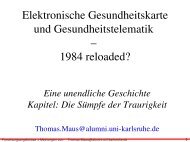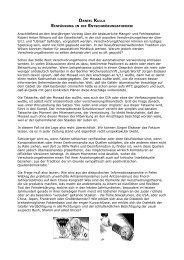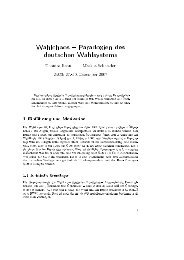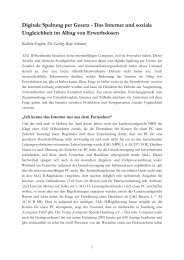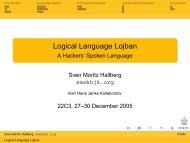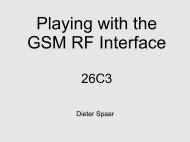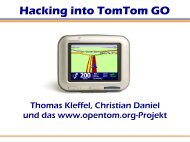Complete Hard Disk Encryption Using FreeBSD's GEOM Framework
Complete Hard Disk Encryption Using FreeBSD's GEOM Framework
Complete Hard Disk Encryption Using FreeBSD's GEOM Framework
You also want an ePaper? Increase the reach of your titles
YUMPU automatically turns print PDFs into web optimized ePapers that Google loves.
# echo “/dev/ad0.elia / ufs rw 1 1” >> /removable/etc/fstab<br />
It is important to note that this file must be stored on the removable medium and<br />
serves only the purpose of specifying the device for the root filesystem. As soon as the<br />
kernel has read out the contents of the file, it will mount the specified device as the root<br />
filesystem and the files on the removable medium (including fstab) will be outside of the<br />
filesystem name space. This means that the removable medium must first be mounted<br />
before the files on it can be accessed through the filesystem name space. It also means,<br />
however, that the removable medium can actually be removed after the root filesystem<br />
has been mounted from the encrypted hard disk – thus reducing unnecessary exposure.<br />
It is crucial that the removable medium be always in the possession of the user, because<br />
the whole concept of complete hard disk encryption relies on the assumption that the<br />
boot medium – therefore the removable medium, not the hard disk – is uncompromised<br />
and its contents are trusted.<br />
If any other partitions need to be mounted in order to boot up the system – for<br />
example /dev/ad0.elid for /usr – they must be specified in /etc/fstab as well. Since most<br />
installations use at least one swap partition, the command for adding the appropriate<br />
entry to /etc/fstab is given below.<br />
# echo “/dev/ad0.elib none swap sw 0 0“ > /fixed/etc/fstab<br />
The system is now ready for use and can be booted from the removable medium. As<br />
the different storage devices in the system are found, GELI searches them for any<br />
partitions that were initialized with the geli init -b parameter and asks for the<br />
passphrase. If the correct one has been provided, GELI will create new device nodes for<br />
plain text access to the hard disk and the partitions on it (e.g. /dev/ad0.elia), which then<br />
can then be mounted as specified in /etc/fstab.<br />
After that, the rest of the system is loaded. sysinstall can then be used in order to<br />
adjust the various settings that could not be set during the installation procedure – such<br />
as timezone, keyboard map and especially the root password!<br />
4 <strong>Complete</strong> hard disk encryption in context<br />
4.1 New defenses & new attack vectors – again<br />
Any user seriously thinking about using complete hard disk encryption should be aware<br />
of what it actually protects and what it does not.<br />
Since encryption requires a lot of processing power and can therefore have a<br />
noticeable impact on performance, it is usually not enabled by default. FreeBSD marks<br />
no exception here. Although it provides strong encryption algorithms and two powerful<br />
tools for encrypting storage media, it is up to the user to discover and apply this<br />
functionality.<br />
This paper gave instructions on how to encrypt an entire hard disk while most of the<br />
operating system is still stored and loaded from it. It is important to remember, however,<br />
that FreeBSD – or any other software component for that matter – will not warn the user<br />
if the encrypted data on the hard disk is leaked (see chapter 2.3) or intentionally copied<br />
to another, unencrypted medium, such as an external drive or a smart media card. It is<br />
the responsibility of the user to encrypt these media as well.<br />
This responsibility applies equally well to data in transit. Network transmissions are<br />
20



